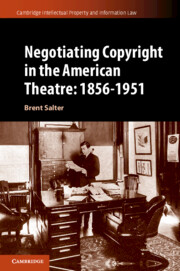Book contents
- Negotiating Copyright in the American Theatre: 1856–1951
- Cambridge Intellectual Property and Information Law
- Negotiating Copyright in the American Theatre: 1856–1951
- Copyright page
- Contents
- Figures
- Tables
- Acknowledgments
- Introduction
- Part I Mediating the American Theatre
- Part II The Organizational Response
- 6 The Playwright Code
- 7 Carl E. Ring and the American Playwright Trade Association
- 8 Trading On “Its Own Inherent Strength”
- Epilogue
- Bibliography
- Index
- Cambridge Intellectual Property and Information Law
8 - Trading On “Its Own Inherent Strength”
from Part II - The Organizational Response
Published online by Cambridge University Press: 23 December 2021
- Negotiating Copyright in the American Theatre: 1856–1951
- Cambridge Intellectual Property and Information Law
- Negotiating Copyright in the American Theatre: 1856–1951
- Copyright page
- Contents
- Figures
- Tables
- Acknowledgments
- Introduction
- Part I Mediating the American Theatre
- Part II The Organizational Response
- 6 The Playwright Code
- 7 Carl E. Ring and the American Playwright Trade Association
- 8 Trading On “Its Own Inherent Strength”
- Epilogue
- Bibliography
- Index
- Cambridge Intellectual Property and Information Law
Summary
In the two years that followed the Second Circuit’s decision to remand the matter for further proceedings in the District Court, the defendants moved to strike the case. Ring successfully appealed the motion to strike and requested a trial by jury. The appeal succeeded in the Second Circuit,1 and the defendants had certiorari denied in the Supreme Court of the United States.2
- Type
- Chapter
- Information
- Negotiating Copyright in the American Theatre: 1856–1951 , pp. 186 - 210Publisher: Cambridge University PressPrint publication year: 2022

